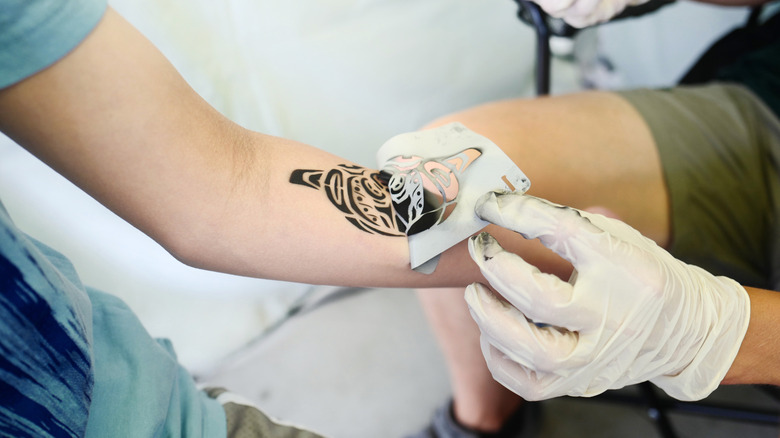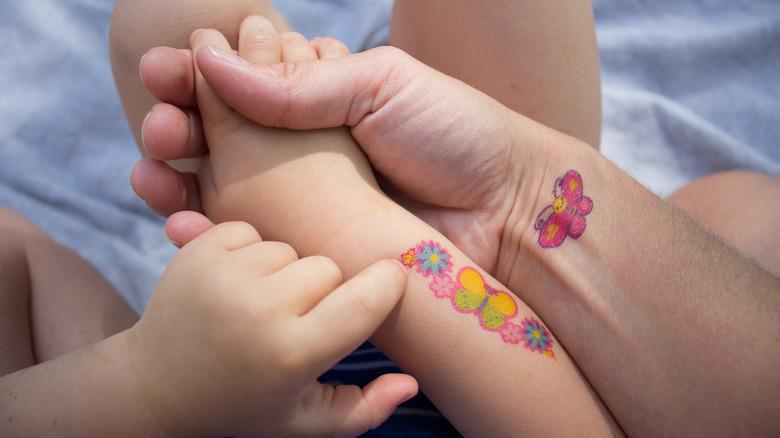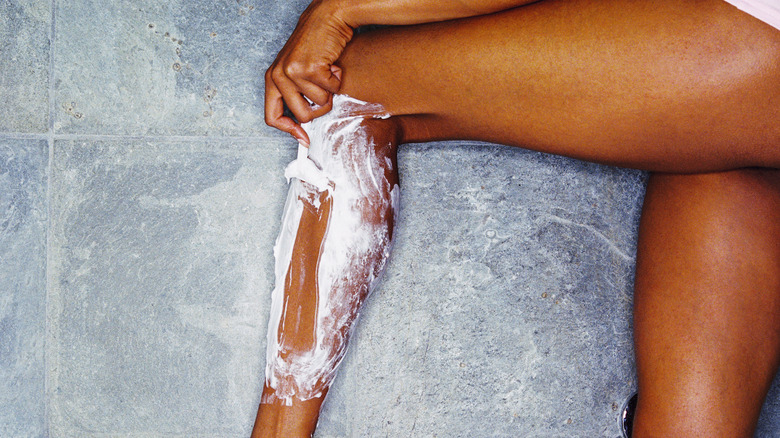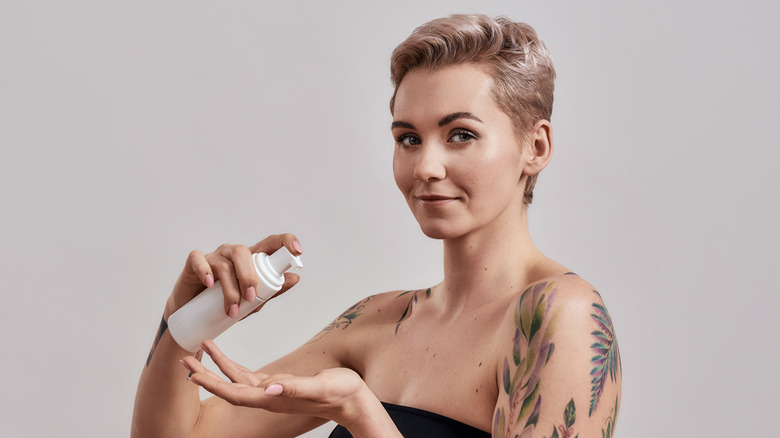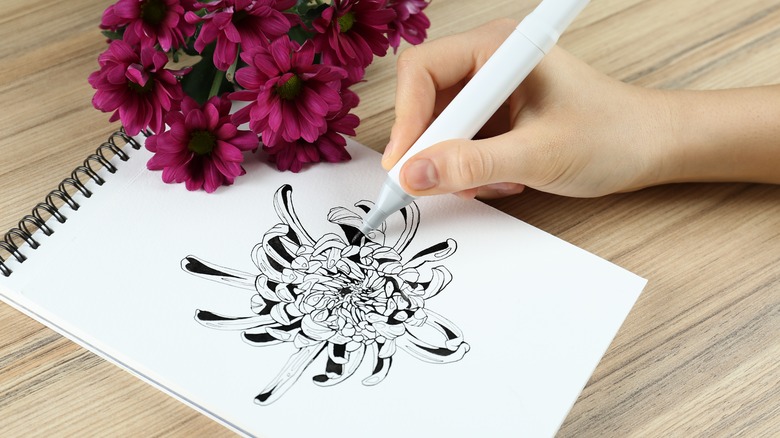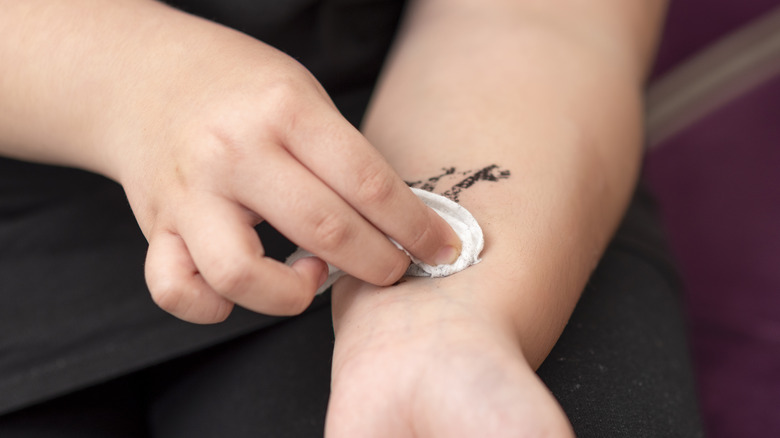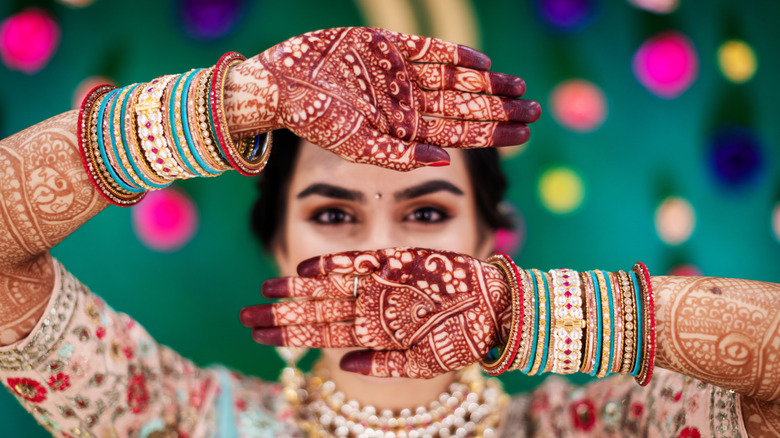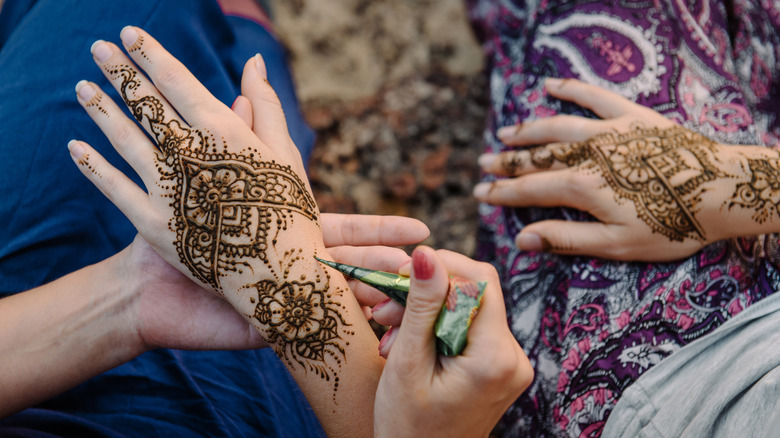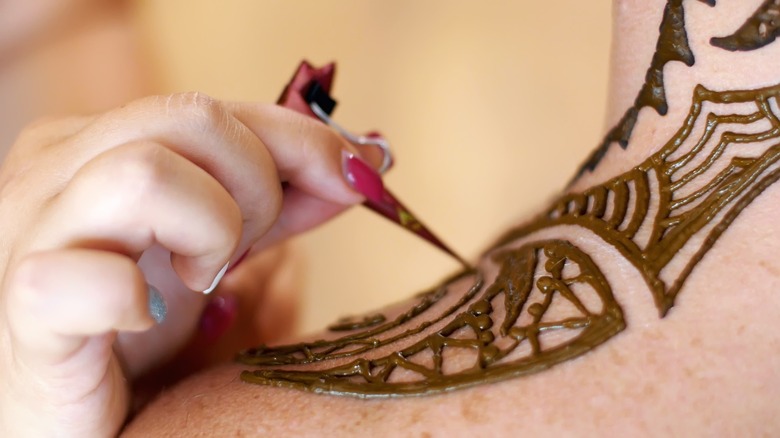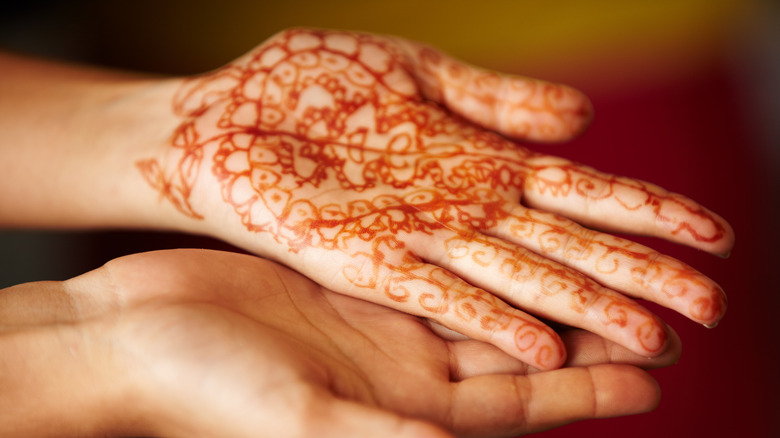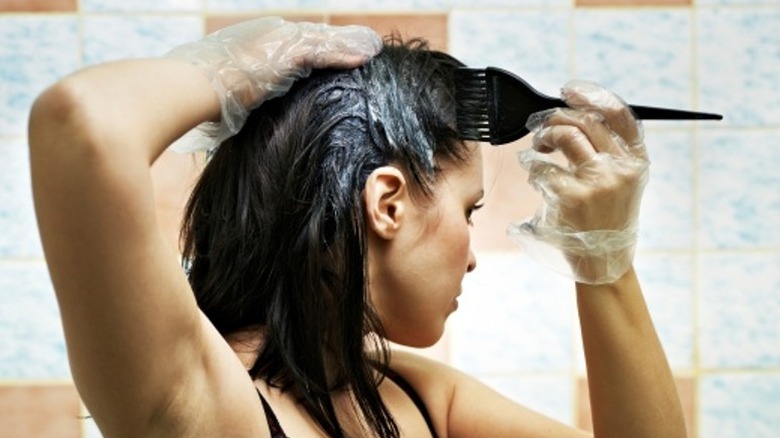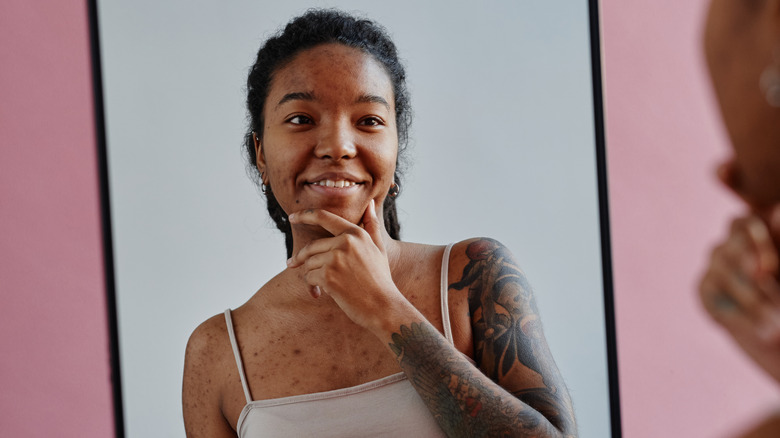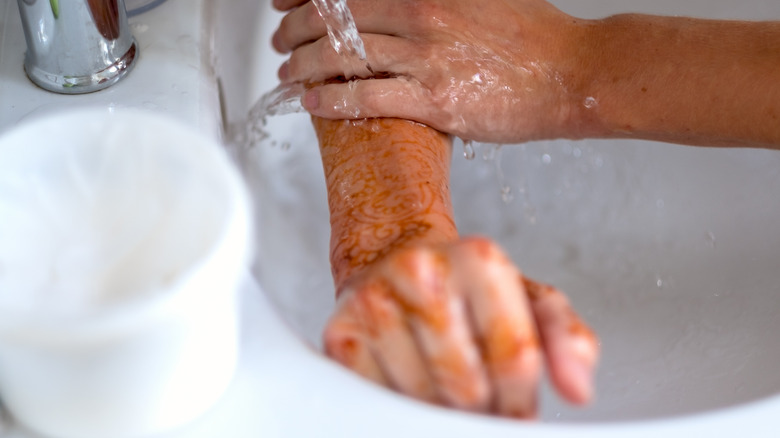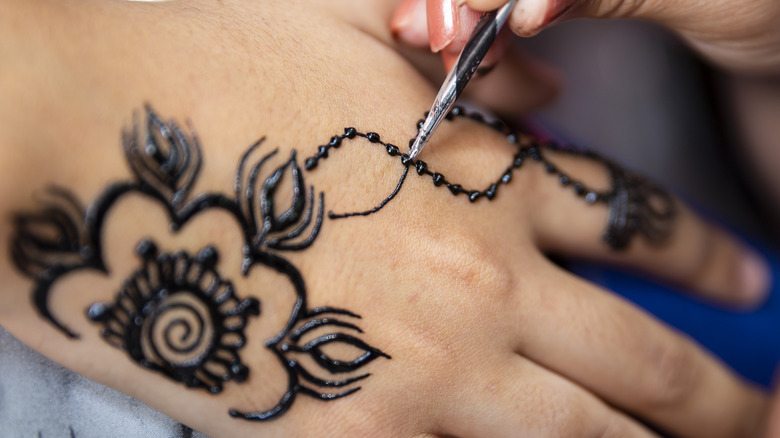The Ultimate Guide To Temporary Tattoos
Are you curious about the prospect of getting tattoos but you don't want to commit to a permanent one just yet? Because of their popularity, it's normal to wonder about self expression via the art of tattoos — it's also normal to be a little on the fence. People use tattoos to tell stories about their favorite childhood memories, moments of trauma they've overcome, pride for where they reside, and so much more.
Tattoos can express someone's unconditional love to others — romantic partners, children, parents, siblings, and best friends all come to mind. They can be used as an alternative form of wedding rings for couples who would rather get their initials tattooed on each other's ring fingers instead of traditional pieces of jewelry. From lyrics to poems, famous paintings to constellations in the sky — really, the inspiration is endless.
Having tattoos is a great conversation starter — jaw-dropping ink that stands out in a crowd will pique the interest of friends, family, and even strangers. All of this being said, it's perfectly fine to experiment with temporary tattoos before going all the way with permanent ink — which is a big commitment.
Here's everything you should know about temporary tattoos, from how long they last to how you can apply them at home DIY-style.
Press-on tattoos only last three to five days
You don't have an abundant amount of time under your belt to have fun with press-on tattoos if these are the types of tattoos you're starting off with. According to Momentary Ink, you can expect your press-on tattoos to last for about three to five days. If you're planning to sport a press-on tattoo for a special event such as a birthday party, bachelorette party, or wedding, you should know ahead of time not to apply your press-on tattoo until the day of or the day before celebrations take place.
If you apply your tattoo too early, it will already start peeling and flaking off before you're ready to see that happen. This is actually great news for anyone planning to sport a press-on tattoo on a holiday weekend like dressing up for Halloween. You know you're only going to need the press-on tattoo for a short period of time, so you won't have to worry about it lingering on your body beyond those three to five days.
Shaving before applying press-on tattoos yields better results
One of the smartest tips to keep up with in terms of press-on tattoos would be shaving before getting started. When you shave your skin before applying press-on tattoos, it yields better results. Applying a press-on tattoo somewhere covered in long hair follicles, or even stubble, won't give you the chance to admire super smooth and clean results. When you take a razor to the area with hair growth first, your chances of seeing every single detail laid out on your skin get way higher.
If shaving your skin with a razor isn't something you're interested in because you'd rather avoid the risk of razor bumps and cuts, you can remove hair using wax strips or sugaring paste as well. An additional option would be using hair removal cream that allows you to gently rinse your hair away after about 10 minutes. Hair removal cream is ideal if you don't want to go through the painful hassle of waxing.
Hair spray and face primer can make press-on tattoos last longer
It's totally possible you're interested in making sure your press-on tattoo last beyond three to five days. One of the reasons you could be seeking this is that you're planning a weeklong vacation. Instead of seeing your press-on tattoo start flaking and fading away by the fifth day at best, you're hoping to see all of its clear details until your vacation comes to an end. A couple of different items you can use in order to achieve longer-lasting press-on tattoos include hairspray and face primer.
Some of the most popular brands of hairspray to consider include BedHead, Suave, and L'Oreal. When you spritz hairspray on your actual hair, it coats each strand with a liquified product that hardens to help it stay in a voluminous position. When you cover your face in primer, it readies your skin to be covered in liquid foundation, highlighter, bronzer, and blush. Hairspray and face primer certainly get the job done in their respective areas, but they also come in handy with press-on tattoos.
You can create DIY press-on tattoos at home
It's easy enough to find cute press-on tattoos in artistic Etsy shops or from various beauty brands. You can also find trendy press-on tattoos at regular department stores and shopping centers if that's what you're on a mission for. Making your own DIY press-on tattoos at home is an additional option for people who want the freedom to get as creative as possible. According to A Beautiful Mess, you can make DIY press-on tattoos at home using printable tattoo paper to draw your own colorful designs.
This idea comes in handy for people who are on the lookout for specific press-on tattoos that they're unable to find anywhere! You might be hoping to find an adorable picture of a green-colored rose with a smiley face on it, but if no one's ever designed that exact press-on style before, you'll be out of luck. Making your own DIY press-ons at home means you'll be able to create exactly what you're looking for based on your own personal preferences and inspired vision.
Remove press-on tattoos early with rubbing alcohol or exfoliating scrub
It's possible you're totally regretting the press-on tattoo you've got on you at the moment. Even though press-on tattoos will start to flake away after three to five days, you might be ready to get rid of them immediately without having the patience to wait it out. If this is the case, you can work on removing your press-on tattoos early with rubbing alcohol or exfoliating scrub. Rubbing alcohol has many uses, including its ability to disinfect bug bites, reduce body odor, and deodorize rancid household scents.
Now, you can add rubbing alcohol to your list as a substance to prematurely get rid of press-on tattoos. Exfoliating scrubs are another fabulous option to use since they help lift press-on tattoos away while also buffing away any rough areas of dead skin cells. By the time you're finished using an exfoliating scrub to remove your press-on tattoo, that one area of skin will feel super soft and smooth compared to everywhere else.
Henna tattoos have cultural significance
Moving beyond press-on tattoos into the realm of henna tattoos might tickle your fancy, but it's important to take note of the history and cultural significance of henna tattoos. According to St. Thomas University, henna tattoo art has been in practice for more than 5,000 years in places such as Africa, India, Pakistan, and the Middle East.
The reason henna tattoo art originally came into existence is that people loved its natural cooling properties as a way of fighting back against blistering climates. Later on, henna tattoos were used to help sick individuals heal from headaches, burns, stomachaches, and surface lesions. Also, henna started being used as a decorative mode that revealed your socioeconomic status.
Those who were able to afford henna tattoo art designs were showing the world how financially secure and well-off they were. When we think of henna tattoos today, we typically connect them to blissful celebrations such as birthdays and weddings. The reason people are now incorporating henna tattoos during celebratory occasions is that henna paste is symbolic of health and prosperity.
Henna tattoos typically last one to five weeks
You can expect a lot more from a henna tattoo than a press-on tattoo when it comes to the length of time it will last. According to Authority Tattoo, henna tattoos last for one to five weeks. On the long end, this means you'll be able to admire your henna tattoo for more than a month if circumstances allow it. Henna binds itself to your skin in a way that press-on tattoos simply aren't capable of.
You can compare it to the way some natural food items and supplements accidentally dye your fingers and hands when you're not being careful. Beets will alter the color of your skin as well as turmeric when you're cooking in the kitchen. Taking a supplement like chlorophyll will also create this type of reaction since the dark green color sinks deep into your skin without easily rinsing away. If your goal is to enjoy the appearance of a gorgeous temporary tattoo for a solid amount of time, a henna tattoo will definitely help you achieve that.
Some amusement parks and carnivals offer henna tattoo services
Finding a fun place to get a henna tattoo is totally possible if you consider amusement parks and local carnivals in your area. Some of the most popular places to get henna tattoos happen to be Disneyland and Disney World. According to Plan Disney, the henna tattoo experience offered at Disney parks is a wonderful way for visitors to get a unique and cultural experience while walking away with a souvenir that will last (on their body) for at least a couple of weeks.
Disney parks offer simple face painting services for youngsters, but henna tattoos give teenagers, young adults, and older folks the chance to enjoy a similar experience on a more mature level. The artist will give you a book full of designs to choose from that are ranked by size and pricing. From there, you decide where you want the Disney park henna artist to draw the design. Other theme parks like Knott's Berry Farm in Buena Park, Calif. offer similar services.
You can do your own DIY henna tattoos at home
Have you ever been curious about doing your own henna tattoos at home? Maybe there aren't any amusement parks near you or henna art isn't offered at tattoo parlors in your area. No worries — it's possible to handle DIY henna tattoo projects in the comfort of your own home, on your own schedule. According to Earth Henna, you can purchase henna tattoo kits filled with safe and easy-to-use products to accomplish exactly what you want.
Their premium kit includes enough henna paste to draw between 20 and 30 designs on your body. They also include flat toothpicks you can use to touch up any potential mistakes, multiple sheets of stencil designs, and one thermal stencil sheet to create your desired image.
If you don't want to use a full-fledged kit, Sarahenna shared their own DIY recipe for henna paste including quality henna powder from a certified organic brand, essential oil, and table sugar.
Some believe henna can be used for health purposes
Some people believe that henna can be used to help with a slew of health conditions. According to WebMD, though, more research must be done before we can fully lean on these claims. Early studies have shown that henna used on the skin positively impacts patients who are facing "chemotherapy-induced acral erythema" while receiving a cancer drug called capecitabine.
Other modes of early research have shown that female patients applying henna powder to their hands and feet were able to lessen nerve damage from using a different cancer drug called oxaliplatin. Pressure ulcers, which are also known as bedsores, were reported to improve with the use of henna powder compared to no treatment or the use of olive oil as an alternative. Again, more studies must be done linking henna to all of its health benefits before scientists and doctors will be convinced about its effectiveness.
Thicker skinned areas are best for henna placements
If you're trying to narrow down which part of your body is best for henna tattoo placement, think about which areas of your skin are thicker. Thicker skinned areas yield superior results since henna paste will last longer and absorb better into those areas. Juhenna Tattoo explains that the two areas where henna will receive the darkest stained results are the palms of your hands and the bottoms of your feet.
The skin on the palms of your hands and bottoms of your feet is thicker than skin anywhere else, which makes sense since you use your hands to grab everything and your feet to walk everywhere. And so, the surfaces of your hands and feet have been through a lot — there's nothing thin or fragile about those areas.
Other areas for henna placement include ankles, legs, back, shoulders, and the insides of your arms. You'll want to avoid areas with the thinnest skin — your eyelids and genitalia, for example.
Henna can be used beyond the surface of your skin
Are you curious about how henna can be used beyond the surface of your skin? If so, we have good news! You can use henna for more than just as a paste that creates stunning designs. Henna can also be used to dye your hair. According to Frontier Co-Op dying your hair with henna is super beneficial because it deeply conditions each strand during the coloring process. Deep conditioning is a factor because henna leaves are jam-packed with something called lawsone.
It's a bitter tannic substance that binds with all the natural keratin protein found in the strands of your hair whenever it gets activated by water. If you're hoping to dye your hair a super dark color, you'll want to mix henna powder with tea, lemon, and vinegar to get the job done. You can also use henna to dye clothing as well! Henna stains clothing permanently, which means you'll be able to admire it as part of your favorite shirts and dresses forever.
Press-on tattoos and henna allow you to temporarily experiment
A huge reason to opt for press-on tattoos and henna tattoos is that these options allow you to temporarily experiment with various ideas. You might be craving a butterfly-shaped tattoo on your lower back, for example. Before going all the way with permanent ink, try having it applied as a press-on or henna to see how you feel about it once it's actually there and visible on your skin.
If you're interested in getting the initials of a loved one tattooed on your ankle or on your wrist, start out with a press-on or henna in the right area to test how you emotionally react to seeing those initials on your body. Once you realize that a press-on tattoo or henna tattoo would look so much better as a permanent fixture, you'll feel more comfortable moving forward with your plans.
It's possible to remove henna tattoos early if needed
A huge benefit of using henna as a temporary tattoo option is that it lasts for one to five weeks. If you decide for any reason that you're ready to get rid of your henna tattoo earlier, you don't have to feel stuck. According to Medical News Today, using micellar water is a great option when trying to rid yourself of henna tattoo residue. The reason for this is that micellar water is cleansing and filled with special particles that help break down pigmentation.
Gently rubbing away at your henna tattoo with a cloth that's been dowsed in micellar water will get the job done. Consider using baking soda as an exfoliator to remove henna tattoos if micellar water isn't on your radar. Stir baking soda together with lemon to create a paste that will help lighten up the visibility of your henna tattoo. Baby oil is another solid option since it does a great job dissolving the pigmentation of henna in skin soaks that last about 20 minutes — just drop a few capfuls of baby oil into your warm bath water and soak away!
Black henna isn't FDA approved
Dealing with henna isn't always fun and games when you become aware of some of the health risks that come into play. Although there's no denying that henna tattoo art can be breathtakingly stunning, there's always a question at the back of peoples minds about how safe it actually is. According to the Food and Drug Administration (FDA), black henna hasn't been approved to be used on skin. In fact, it's only been approved to be used in hair.
The unfortunate reason for this is that black henna contains a dangerous ingredient called phenylenediamine (PPD). Serious skin reactions can occur in people using black henna who aren't physically equipped to handle such a powerful ingredient. Since black henna isn't approved by the FDA, you'll have to be careful when it comes to making your decision about using it. One way to protect yourself would be testing a small area of skin before getting a large henna tattoo that covers a massive surface space.
